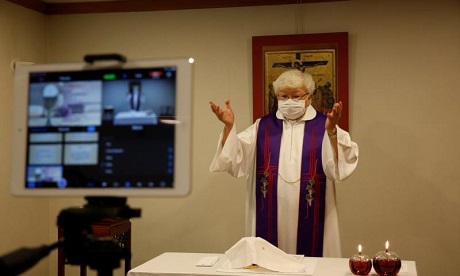Digital media Masses need guidelines to set them apart from other TV shows people watch, theologian Dr. Katherine Schmidt says.
“There are ways to make choices in our livestreams and recordings that mark them as a different kind of space, a sacred space, to minimize distractions,” she says.
Schmidt, who has been studying the relationship between digital culture and the church for the past decade at Molloy College
“If you’ve ever been part of planning a big liturgy, you know that all the details matter immensely,” she says.
This means it matters where the cameras are placed and how well the audio is working and it’s necessary to consider the viewer’s needs.
Schmidt says this week she spent some time analyzing a range of virtual Masses from the past weekend, focusing on the ones that weren’t doing them before the pandemic.
“The main thing that stuck with me was the frequent use of a single camera that’s really high up and really far away.
“It’s very alienating and cold. Then you have some parishes that are using multiple camera angles, where someone is selecting which camera to use at various points during the liturgy.
“But I’m not so sure about that either, because someone’s making the choice for you about where to look. Some people might say, “Oh who cares?
“We’ve been saying for millennia that the smallest details in the liturgy matter, so why wouldn’t it matter where the camera is pointing?”
The way forward would be for the bishops’ conference or individual bishops to issue some guidelines that say, “Hey, if you’re going to livestream your parish, here are certain things that you need to do.”
In Schmidt’s opinion, issuing this type of guidance is s really no different than saying you have to use real candles and a chalice made of “noble materials” at Mass.
In the online Mass guidelines, advice would be given about “having your camera at a certain angle, close enough to the altar, that sort of thing,” she says.
No matter how immersive the virtual experience of Mass gets, Schmidt says she thinks there will be a break during the Eucharist, “where we see the seams of the virtual experience that show that it’s not quite perfect.
“There’s this break where we realize, oh no, I can’t actually partake in this Eucharist. In our sacramental imagination, it’s important we hold onto the fact that this is a real break,” she says.
Clergy need to be open to others using digital technology – even if they’re not using it themselves, she advises.
Emails, Facebook messages, and other digital connections help make bonds between parishioners.
These bonds are especially important in a “suburbanized” era for the church where parishioners are often geographically, physically and socially separated from each other, Schmidt says.
Source
